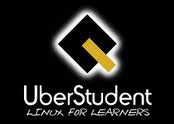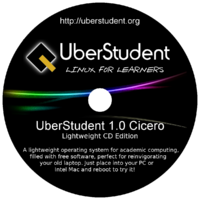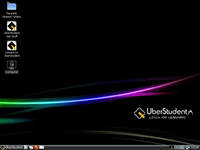COMP 3000 2011 Report: UberStudent
Raison d’être
The name “UberStudent” has a memorable, if not slightly nerdy, ring to it. In the swirl of educational software available, both free and not, that is probably a good thing. UberStudent is a free Linux distribution for “learning, doing, and teaching academic success at the higher education and advanced secondary levels.” Essentially, its purpose is to wrap all the software needs of an academic into a single intuitive package, leaving users to focus on their studies.
It was founded by Stephen Ewen, who holds a masters degree in adult education. At its core, UberStudent is built on Debian, but pulls into play ideas from other distros, notably Ubuntu and Mint. This review will only look at the lightweight edition 1.0 "Cicero", which runs the simple LXDE GUI and fits on a CD as opposed to the full DVD edition.
Note that the full edition contains substantially more software as well as including the GNOME desktop. Although being six times the size, it retains the live CD capability of the lightweight version.
Installation and Startup
From the moment we powered up our virtual machine to the first sign of the UberStudent’s LXDE desktop, we waited one minute. That was on a recent MacBook Pro running Parallels 6. The machine was defined as a single core with 1 GB of RAM and a 10 GB drive. Note that our laptop actually runs on a 64 GB SSD drive, and live CD booting in a virtual machine likely benefits heavily from the random-access performance boost. For whatever reason, that duration didn’t change when we allowed the virtualized PC access to both the laptop’s CPU cores.
Once satisfied that the live CD was working, the next step was to take the plunge and ask it to install a complete copy on the hard drive.
UberStudent was quite snappy at this, and came back in less than four minutes to ask us to reboot. Before and after the reboot, the system was always very responsive and stable (trust us there are distros that are totally unusable even within the first few minutes of running).
The live CD ISO image downloaded from the official website was 660 MB, and the final size of the guest filesystem’s disk image including Parallels Tools was 3.5 GB. For the record, Parallels worked flawlessly with everything, from shared folders to networking to mouse sharing.
Features
UberStudent listed 39 programs and links under the Education menu. Keep in mind that this was just the light edition, which is severely cramped for space because it fits on a single CD. The programs are nicely grouped into useful submenus, not too deep but not too clumped either. The selection is designed to cover reading, writing, personal finances, time management, and task planning.
Lest a user become bored with the often dry world of “education”, the distro includes various other tools and the obligatory Games menu. There are image editors, photograph colour tools, and music editors. An entire menu is even dedicated to links to online cloud-based offerings, including BitStorm Lite, Google Reader, and EyeOS.
One simple feature that underlines UberStudent’s credibility as a well thought out integrated academic system is the default homepage in Firefox. It takes the user to a portal page on the official website, with instant access to various online resources. It almost goes without saying there is a Google search box there, but only in addition to an Ixquick search box.
Security and Networking
The Debian approach to security is as modern as desktop computer security gets. The maintainers do not believe in security by obscurity, and the operating system has built-in updating capabilities. A mailing list is published for anyone who wants to keep up to date with the latest security announcements. UberStudent also brings with it a large part of Ubuntu’s natural simplicity.
As shown by the large amount of Internet-related resources and cloud-based tools in the distro, UberStudent cares about the web a lot. The developers confirm this by leaving easy to access links in the main menu that take the user to driver and codec download sites.
Software Packaging
As just implied, UberStudent does not come with restricted codecs and drivers by default, but makes it easy to get them if desired. Again, the Debian and Ubuntu heritage means there will never be a problem of finding software and drivers and keeping them updated.
Ease of Use
LXDE is designed with a primary goal of being “extremely fast-performing and energy-saving”, as moderately opposed to the GNOME desktop’s mission statement that describes itself as “intuitive and attractive”. Again, the full version of UberStudent hits like a sledgehammer with the latest copy of GNOME.
Even from our limited experience with the distro, we can describe the interface and organization as functional and well designed.
Summary
Well, quite honestly this Linux distribution is a welcome relief from the large amount of educational software available that is well meaning yet not quite there. This packages a large amount of material that a student would need to make it through their studies without being cluttered or bloated. The creators must have spent quite a bit of time searching for things to include, as well as integrating them nicely into a system that feels like a unit. We are very tempted to go have a peek at the full edition of UberStudent, and what else it could possibly bring to the table.



